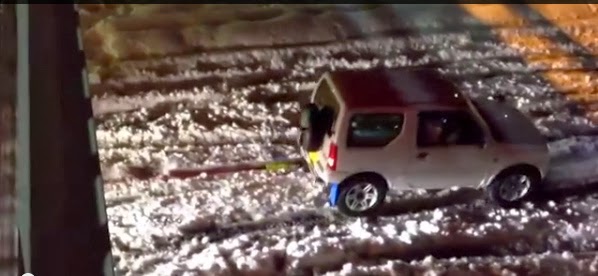Powerful Jimny Tugs Truck Stuck with Heavy Snow in Kanto /
What Yamazaki Bread Company Got and What TV Stations Lost due to Historic Heavy Snow – Collapse of Old Concept of Values –
I don’t think
that a light motor vehicle Jimny can tug a truck with a loading capacity of 10
tons. Probably the Jimny is tugging the
truck with normal tires which skids on the snow. The footage has a powerful impact on
viewers. If a driver of the light motor
vehicle and a person who shot a video are identified, both of them will be presented
with money and a letter of appreciation by Suzuki.
The second
article well describes an incident of historic heavy snow. Seeing how NHK and commercial TV stations
reported this incident, I thought the current Japan has gone stark mad. On the other hand, there was something
wonderful that has awakened people; this kind of video and the performance of
Mao Asada, which is totally different from fierce competitions to win
medals. Apparently, the old concept of
values is being destroyed.
Masatoshi Takeshita
February 22, 2014
----------
English
translation of an excerpt from a Japanese article: Netafuru – February
17, 2014 –
[Video] Powerful Jimny Tugs Truck Stuck with Heavy
Snow in Kanto
What?
This is a truck with
a loading capacity of 10 tons, isn’t it?
At any rate, the video tells the awesome
performance of Jimny, a light motor vehicle with an engine size of 660 cc.
We have often
heard about good performance of Jimny on the Internet. This video makes us realize it is true.
----------
English
translation of an excerpt form a Japanese article: BILOBE* All About –
February 21, 2014 –
What Yamazaki Bread Company Got and What TV Stations
Lost due to Historic Heavy Snow
Have TV stations greatly
reduced their significance of existence?
Heavy snow hit
the Kanto area at the start of February.
On February 14, a historic heavy snow hit the Kanto area. Emergency news program on it had not been
produced, though it was such a serious incident fatal to humans. What
was even worse is that information on afflicted
areas including Yamanashi Prefecture had not
been reported soon in ordinary news.
What made such situation is, as you
know, connected with the Sochi Olympic Games
*Olympic Games Cant’ be Ignored
The Olympic Games
is held every four years. It is a big market in which a total of tens of billions of yen of
support money is financed by only dozens of supporting companies. Additionally, supporting
sponsors in the Olympic Games not only support the Games but also engage in the entire advertising related to the Games,
which include producing TV commercials, broadcasting
games, and carrying on campaigns.
Computing the total amount of money, it runs as high as tens of billions
of yen.
The Olympic Games
is a quadrennial big event for TV stations as well as
for sponsors and advertising companies.
However, is it
the event that has to be prioritized under a critical situation where heavy
snow might control the life and death of people? The answer is definitely “NO.”
*TV Stations Lose Role of News Media
Information on heavy snow, which is not reported on TV, has been available
mainly through social media. On Twitter, many people worrying about their
safety let out their voice. People have
become aware of the fact that now isn’t the time to enjoy watching the Olympic
Games because there are areas so heavily affected by heavy snow.
One of what TV stations have lost is the position as news media. They have no information
and transmit information so slowly. TV
stations gave up the role as news media, which is desperately needed in such an
emergency.
*TV Stations Lose Value as Publicity Agent
TV stations have lost not only the role as news media but the value as publicity agent. It was a company
which splendidly responded to heavy snow that has
increased its business valuation.
Let’s take a
driver for example. A truck driver from the Yamazaki bread company, who
was also stuck in heavy snow in Kofu, handed out bread from
his truck to many helpless people around him and at a highway service
station. The driver has been praised
since information on his response was shared by around 19,000 twitters during
24 hours after his response. Subsequently, this case was
introduced by the media such as the Yomiuri Shimbun, which learned about
it on Twitter.
As engaged in PR
field, I convert news into advertising cost.
Usually, this kind of news is reported by major Internet media and
newspapers and introduced as an information program by TV stations. In many cases, it amounts to some 500 million
– 1 billion yen as advertising cost.
However, since this case was not introduced as news so often by TV
stations, it will amount to approximately 200 million
yen in terms of advertising cost alone.
On top of that, the share price of Yamazaki, which stood at around 1,110 yen
on February 14, rose to around 1,170 yen afterward, which is a rise of
13 billion yen in terms of money.
I’d like to
introduce another case, that it, Suzuki Jimny.
A video of Suzuki Jimny tugging a stuck truck was uploaded on YouTube more
than once. The
footage showing a small car pulling a big truck has been replayed more than 1 million times in total. As a result, it produced a far more advertising effectiveness than ordinary
advertisement or promotion.
TV has
significantly reduced its value as news media over the
past two weeks from February 8.
Furthermore, it has significantly reduced its value as publicity agent.
As extensive damages due to heavy snowfall have been revealed, more people get to doubt if what is broadcast on TV is sufficient
and credible.
It is not, of
course, that TV ratings will suddenly decline.
Undoubtedly, however, silent Japanese have gradually felt disappointed at TV
stations.
(Hiroshi Arai)


